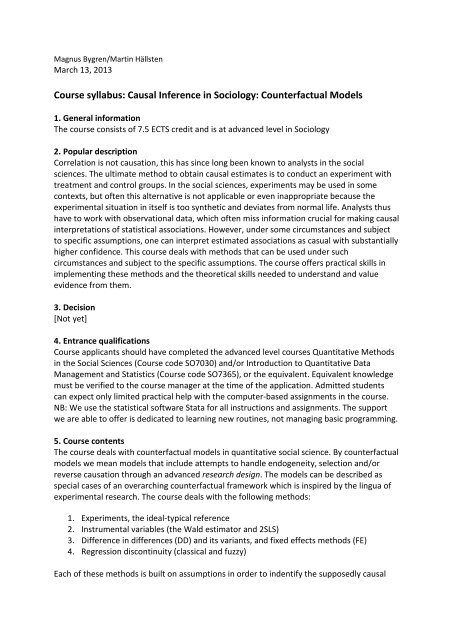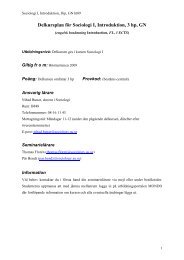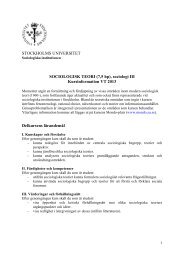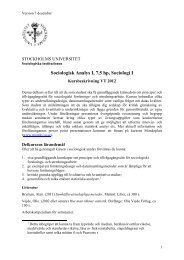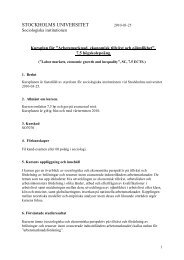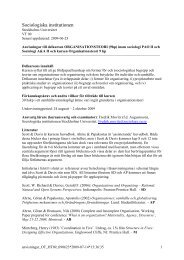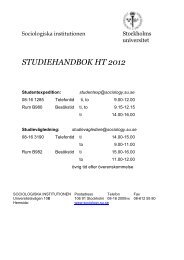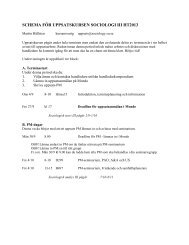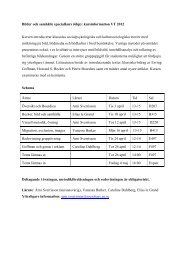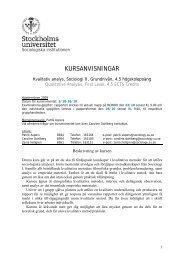Course syllabus: Causal Inference in Sociology: Counterfactual ...
Course syllabus: Causal Inference in Sociology: Counterfactual ...
Course syllabus: Causal Inference in Sociology: Counterfactual ...
You also want an ePaper? Increase the reach of your titles
YUMPU automatically turns print PDFs into web optimized ePapers that Google loves.
Magnus Bygren/Mart<strong>in</strong> Hällsten<br />
March 13, 2013<br />
<strong>Course</strong> <strong>syllabus</strong>: <strong>Causal</strong> <strong>Inference</strong> <strong>in</strong> <strong>Sociology</strong>: <strong>Counterfactual</strong> Models<br />
1. General <strong>in</strong>formation<br />
The course consists of 7.5 ECTS credit and is at advanced level <strong>in</strong> <strong>Sociology</strong><br />
2. Popular description<br />
Correlation is not causation, this has s<strong>in</strong>ce long been known to analysts <strong>in</strong> the social<br />
sciences. The ultimate method to obta<strong>in</strong> causal estimates is to conduct an experiment with<br />
treatment and control groups. In the social sciences, experiments may be used <strong>in</strong> some<br />
contexts, but often this alternative is not applicable or even <strong>in</strong>appropriate because the<br />
experimental situation <strong>in</strong> itself is too synthetic and deviates from normal life. Analysts thus<br />
have to work with observational data, which often miss <strong>in</strong>formation crucial for mak<strong>in</strong>g causal<br />
<strong>in</strong>terpretations of statistical associations. However, under some circumstances and subject<br />
to specific assumptions, one can <strong>in</strong>terpret estimated associations as casual with substantially<br />
higher confidence. This course deals with methods that can be used under such<br />
circumstances and subject to the specific assumptions. The course offers practical skills <strong>in</strong><br />
implement<strong>in</strong>g these methods and the theoretical skills needed to understand and value<br />
evidence from them.<br />
3. Decision<br />
[Not yet]<br />
4. Entrance qualifications<br />
<strong>Course</strong> applicants should have completed the advanced level courses Quantitative Methods<br />
<strong>in</strong> the Social Sciences (<strong>Course</strong> code SO7030) and/or Introduction to Quantitative Data<br />
Management and Statistics (<strong>Course</strong> code SO7365), or the equivalent. Equivalent knowledge<br />
must be verified to the course manager at the time of the application. Admitted students<br />
can expect only limited practical help with the computer-based assignments <strong>in</strong> the course.<br />
NB: We use the statistical software Stata for all <strong>in</strong>structions and assignments. The support<br />
we are able to offer is dedicated to learn<strong>in</strong>g new rout<strong>in</strong>es, not manag<strong>in</strong>g basic programm<strong>in</strong>g.<br />
5. <strong>Course</strong> contents<br />
The course deals with counterfactual models <strong>in</strong> quantitative social science. By counterfactual<br />
models we mean models that <strong>in</strong>clude attempts to handle endogeneity, selection and/or<br />
reverse causation through an advanced research design. The models can be described as<br />
special cases of an overarch<strong>in</strong>g counterfactual framework which is <strong>in</strong>spired by the l<strong>in</strong>gua of<br />
experimental research. The course deals with the follow<strong>in</strong>g methods:<br />
1. Experiments, the ideal-typical reference<br />
2. Instrumental variables (the Wald estimator and 2SLS)<br />
3. Difference <strong>in</strong> differences (DD) and its variants, and fixed effects methods (FE)<br />
4. Regression discont<strong>in</strong>uity (classical and fuzzy)<br />
Each of these methods is built on assumptions <strong>in</strong> order to <strong>in</strong>dentify the supposedly causal
effect. These assumptions are critical to the <strong>in</strong>terpretation of quantitative estimates, and not<br />
empirically testable. A great deal of the course revolves around the different assumptions<br />
<strong>in</strong>voked when us<strong>in</strong>g counterfactual models.<br />
6. Expected learn<strong>in</strong>g outcomes<br />
The course has two different expected learn<strong>in</strong>g outcomes. After the course, the student is<br />
expected to be able to<br />
a. Conduct analyses based on a counterfactual design, i.e., use, and <strong>in</strong>terpret output<br />
from, counterfactual models<br />
b. Describe and expla<strong>in</strong> the counterfactual designs work, <strong>in</strong>clud<strong>in</strong>g:<br />
‒ Understand the motivation for and the theoretical underp<strong>in</strong>n<strong>in</strong>gs of common<br />
counterfactual designs<br />
‒ Critically exam<strong>in</strong>e and discuss <strong>in</strong>ternal and external validity <strong>in</strong> relation to<br />
common counterfactual models<br />
‒ Discuss merits and limitations of counterfactual designs for specific research<br />
topics<br />
7. <strong>Course</strong> organization and <strong>in</strong>struction<br />
The course is provided at half time dur<strong>in</strong>g 10 weeks. The course is organized around 4<br />
mandatory assignments, with <strong>in</strong>troductory and thematic lectures and voluntary computer<br />
laboratories as supplementary learn<strong>in</strong>g resources.<br />
7.1. <strong>Course</strong> assignments<br />
The course consists of four mandatory written assignments. Three computer assignments<br />
deal with methods 2-4 listed under <strong>Course</strong> contents, where students perform estimation on<br />
a provided dataset and write a short report. The assignment report may conta<strong>in</strong> a maximum<br />
of three tables/graphs and 1500 words, and are to be handed <strong>in</strong> by teams with two students<br />
<strong>in</strong> each team. Each report should beg<strong>in</strong> with a general description of the counterfactual<br />
method – if necessary us<strong>in</strong>g formal language – and expla<strong>in</strong> the <strong>in</strong>ner work<strong>in</strong>gs of it us<strong>in</strong>g<br />
relevant references to the methodological literature. The composition of the student teams<br />
are changed for each assignment and decided by the teacher. The reports are presented<br />
orally at a sem<strong>in</strong>ar as a part of the formative assessment.<br />
The assignments are organized around peer review: for the computer assignments, teams<br />
are paired and shall provide constructive comments and, if applicable, also practical help<br />
dur<strong>in</strong>g the work with the assignments.<br />
Assignments 1-3 are graded accord<strong>in</strong>g to the follow<strong>in</strong>g scale: Pass (P) Fail (F). In order to<br />
receive at least grade E on the entire course, assignments 1-3 all have to be graded P.<br />
The fourth assignment is to <strong>in</strong>dividually write a critical exam<strong>in</strong>ation of published work <strong>in</strong> a<br />
research field of the student’s choice, present a research design employ<strong>in</strong>g one or more<br />
methods covered by the course, describe its theoretical underp<strong>in</strong>n<strong>in</strong>gs, have a realistic plan<br />
to collect/f<strong>in</strong>d real data us<strong>in</strong>g this design, and discuss strengths and weaknesses of such a<br />
research endeavor <strong>in</strong> relation to its potential contribution to the accumulated knowledge <strong>in</strong><br />
the research field (maximum 3000 words). Because this assignment is more demand<strong>in</strong>g, the
amount of time and the number of sem<strong>in</strong>ars devoted to review<strong>in</strong>g is doubled. This <strong>in</strong>dividual<br />
assignment is also presented orally at two regular sem<strong>in</strong>ars, and two student peer-review<br />
sem<strong>in</strong>ars as part of the formative assessment. As for the computer assignments, students<br />
are organized <strong>in</strong> pairs and shall provide constructive comments dur<strong>in</strong>g the work with it.<br />
Assignment 4 is graded accord<strong>in</strong>g to the scale A-F (cf. grad<strong>in</strong>g criteria below), and forms the<br />
ma<strong>in</strong> basis for the <strong>in</strong>dividual grades on the course.<br />
In sum, each assignment <strong>in</strong>volves giv<strong>in</strong>g peer-review dur<strong>in</strong>g the work with the assignment,<br />
writ<strong>in</strong>g a report, conduct<strong>in</strong>g an oral presentation at a sem<strong>in</strong>ar, and contribut<strong>in</strong>g to a critical<br />
discussion on the sem<strong>in</strong>ars.<br />
All assignments are to be uploaded to the Mondo course site no later than one week after<br />
the f<strong>in</strong>al sem<strong>in</strong>ar. If a student fails to meet this deadl<strong>in</strong>e or submits at least one assignment<br />
with substantial errors, s/he may (re)submit a (revised) assignment no later than six months<br />
after the f<strong>in</strong>al sem<strong>in</strong>ar. At this po<strong>in</strong>t <strong>in</strong> time the course teachers will assess the grad<strong>in</strong>g of the<br />
student’s revised assignments. If a student fails yet aga<strong>in</strong> on this occasion, assessment of<br />
revised assignments will only take place the next time the course is given.<br />
7.2. Instruction<br />
Introductory meet<strong>in</strong>gs and sem<strong>in</strong>ars for course assignments<br />
Instructions for the assignments (1) through (4) are given at the lectures, where<br />
student pairs and peer-review pairs are organized. These student pairs will change across<br />
assignments. The assignments are additionally presented at sem<strong>in</strong>ars where the course<br />
<strong>in</strong>structors give feedback.<br />
Lectures<br />
The course offers four lectures:<br />
1. Lecture 1<br />
a. Introduction to counterfactual models. <strong>Counterfactual</strong> vs. parametric<br />
methods for causal <strong>in</strong>ference. Experiments. The focus is to learn the<br />
overarch<strong>in</strong>g concepts <strong>in</strong> counterfactual models <strong>in</strong> mathematical l<strong>in</strong>gua, issues<br />
of external and <strong>in</strong>ternal validity, homogeneous or heterogeneous effects, the<br />
standard threats to causal <strong>in</strong>ferences and to give a background of the limits of<br />
standard statistical techniques, <strong>in</strong> particular the realism of the conditional<br />
<strong>in</strong>dependence assumption. Key concepts covered: average treatment effect<br />
(ATE), the local average treatment effect (LATE), the marg<strong>in</strong>al treatment<br />
effect (MTE), the quantile treatment effect (QTE), the stable unit treatment<br />
value assumption (SUTVA)<br />
b. Orientation on the course structure.<br />
2. Lecture 2: Difference <strong>in</strong> differences and fixed effects methods<br />
3. Lecture 3: Instrumental variables<br />
4. Lecture 4: Regression discont<strong>in</strong>uity<br />
5. Lecture 5<br />
a. <strong>Counterfactual</strong> models from a theory of science perspective. The first part of<br />
this lecture reviews the history of counterfactual thought <strong>in</strong> the theory of
science, and discusses some of the epistemological implications of this<br />
tradition. The second part reviews and discusses the critique it has been<br />
subject to.<br />
b. Sem<strong>in</strong>ar: Explanation and causal <strong>in</strong>ference <strong>in</strong> the social sciences (student-pairs<br />
prepare questions based on thematic issues of AJS and JEL)<br />
Computer laboratories<br />
We offer five different computer laboratories with a focus <strong>in</strong> practical skills needed <strong>in</strong> order<br />
to conduct assignments (1) to (3). The topics of the laboratories are:<br />
1. Difference <strong>in</strong> differences (DD) and fixed effects regressions<br />
2. Instrumental variables<br />
3. Regression discont<strong>in</strong>uity<br />
The laboratories are semi-<strong>in</strong>teractive, with a mix of teacher provided <strong>in</strong>struction and work<br />
on assignments.<br />
<strong>Course</strong> schedule<br />
Calendar<br />
Week Date Time Room Content Teacher<br />
14<br />
15<br />
Wed April 3 12-17 B397 Lecture 1, Lecture 2 & assignment 1<br />
prep<br />
Wed April 10 13-15 B389 Reserved time for student peer<br />
review Assignment 1<br />
MH+MB<br />
-<br />
16 Thur April 18 13-16 B389 Lecture 3 & assignment 2 prep MB<br />
16 Wed April 17 13-15 B397 Sem<strong>in</strong>ar on Assignment 1 MH<br />
17<br />
Wed April 24 13-15 B397, Reserved time for student peer<br />
review Assignment 2<br />
-<br />
Tue April 30 13-15 B397 Sem<strong>in</strong>ar on Assignment 2 MB<br />
18 Thur May 2 13-16 B389 Lecture 4 & Assignment 3 prep MH<br />
19<br />
Wed May 8 13-15 B389 Reserved time for student peer<br />
review Assignment 3<br />
-<br />
Wed May 15 13-15 B389 Sem<strong>in</strong>ar on Assignment 3 MH<br />
20 Thur May 16 13-16 B389 Lecture 5 & assignment 4 prep MB<br />
21 Wed May 22 13-15 B389 Sem<strong>in</strong>ar on Assignment 4 MH+MB<br />
22<br />
Wed May 29 13-15 B389 Reserved time for student peer<br />
review Assignment 4<br />
-<br />
23 Tue June 4 13-16 B389 Sem<strong>in</strong>ar on Assignment 4 MH+MB
8. Exam<strong>in</strong>ation<br />
The grad<strong>in</strong>g criteria are hierarchical (to receive a higher valued grade, all requirements of the<br />
lower levels need to be fulfilled for a higher grade), and are qualitatively different.<br />
Grade<br />
A<br />
B<br />
C<br />
D<br />
E<br />
Fx<br />
F<br />
Expected learn<strong>in</strong>g outcome (a): Describe and expla<strong>in</strong> counterfactual<br />
research designs<br />
The student can <strong>in</strong>dependently identify opportunities for unexploited<br />
counterfactual research designs for a specific research topic, and discuss<br />
and weight merits and limitations of these.<br />
The student can <strong>in</strong>dependently discuss issues of <strong>in</strong>ternal and external<br />
validity of counterfactual designs for a specific research topic.<br />
The student can provide a clear account of the theoretical underp<strong>in</strong>n<strong>in</strong>gs of<br />
counterfactual designs for a specific research topic.<br />
The student can give a clear account of the problems <strong>in</strong>volved <strong>in</strong> the<br />
estimation of causal effects us<strong>in</strong>g observational data and motivate the use<br />
of counterfactual research designs for a specific research topic.<br />
The student can use, and <strong>in</strong>terpret output from, counterfactual research<br />
designs.<br />
The student makes errors <strong>in</strong> describ<strong>in</strong>g, or expla<strong>in</strong><strong>in</strong>g, counterfactual<br />
research designs. The student makes errors <strong>in</strong> the use, or the <strong>in</strong>terpretation<br />
of output from, counterfactual research designs.<br />
The student cannot describe and expla<strong>in</strong> counterfactual research designs.<br />
The student cannot use, or <strong>in</strong>terpret, output from counterfactual research<br />
designs. The course has to be taken <strong>in</strong> its entirety at a later po<strong>in</strong>t <strong>in</strong> time.<br />
9. Literature<br />
There is one course book that is required read<strong>in</strong>g. In addition to the book, articles some of<br />
which are listed below will have to be read <strong>in</strong> advance of lectures/sem<strong>in</strong>ars. The teachers<br />
will give read<strong>in</strong>g <strong>in</strong>structions dur<strong>in</strong>g the course.<br />
<strong>Course</strong> book (required read<strong>in</strong>g)<br />
Angrist, Joshua D., and Jörn-Steffen Pischke. 2009. Mostly harmless econometrics: an<br />
empiricist's companion. Pr<strong>in</strong>ceton: Pr<strong>in</strong>ceton University Press.<br />
Articles (more specific read<strong>in</strong>g <strong>in</strong>structions will be announced dur<strong>in</strong>g the course)<br />
Overview/background<br />
Gangl, M. 2010. “<strong>Causal</strong> <strong>Inference</strong> <strong>in</strong> Sociological Research” Annual Review of <strong>Sociology</strong><br />
36:21-47.<br />
Freeman, David A. “Statistical Models and Shoe Leather” Sociological Methodology, 21:291-<br />
313.
Morgan, Stephen L., and Christofer W<strong>in</strong>ship. 2007. <strong>Counterfactual</strong>s and causal <strong>in</strong>ference:<br />
Methods and pr<strong>in</strong>ciples for social research. New York, NY: Cambridge University<br />
Press.<br />
Thematic issues of scientific journals<br />
“Symposium: Con out of Economics”, Journal of Economic Literature, Vol 24(2): 3-94.<br />
“Mov<strong>in</strong>g to Opportunity: A Symposium”, American Journal of <strong>Sociology</strong>, Vol 114(1): 107-231.<br />
Experiments<br />
Shelley J. Correll, Stephen Benard, and In Paik. 2007. “Gett<strong>in</strong>g a Job: Is There a Motherhood<br />
Penalty? American Journal of <strong>Sociology</strong>, 112:1297-1338.<br />
Fuegen, K., Biernat, M., Ha<strong>in</strong>es, E. & Deaux, K. 2004. ”Mothers and Fathers <strong>in</strong> the Workplace:<br />
How Gender and Parental Status Influence Judgments of Job-Related Competence.”<br />
Journal of Social Issues 60:737-754.<br />
Pager, Devah, Western, Bruce, and Bart Bonikowski, 2009. Discrim<strong>in</strong>ation <strong>in</strong> a Low-Wage<br />
Labor Market: A Field Experiment. American Sociological Review, 74:777-799.<br />
Fershtman, Chaim, Gneezy, Uri. 2001. Discrim<strong>in</strong>ation <strong>in</strong> a Segmented Society: An Experimental<br />
Approach The Quarterly Journal of Economics 116 (1): 351-377.<br />
DD, DDD<br />
Gold<strong>in</strong>, C. & Rouse, C. Orcestrat<strong>in</strong>g Impartiality: the impact of “bl<strong>in</strong>d” auditions on female<br />
musicians. American Economic Review, 90:715-741.<br />
Ruhm, Christopher J. 1998. “The Economic Consequences of Parental Leave Mandates:<br />
Lessons from Europe.” Quarterly Journal of Economics 113:285-317.<br />
Fixed effects<br />
Bygren, M. and Gähler, M. 2012. ”Family Formation and Men’s and Women’s Atta<strong>in</strong>ment of<br />
Workplace Authority.” Social Forces, doi: 10.1093/sf/sor008.<br />
Isacsson, Gunnar. 2004. "Estimat<strong>in</strong>g the economic return to educational levels us<strong>in</strong>g data on<br />
tw<strong>in</strong>s." Journal of Applied Econometrics 19:99-119.<br />
—. 2007. "Tw<strong>in</strong> Data vs. Longitud<strong>in</strong>al Data to Control for Unobserved Variables <strong>in</strong> Earn<strong>in</strong>gs<br />
Functions – Which Are the Differences?*." Oxford Bullet<strong>in</strong> of Economics and<br />
Statistics 69:339-362.<br />
Nordström Skans, Oskar. 2004. "Scarr<strong>in</strong>g effects of the first labour market experience: A<br />
sibl<strong>in</strong>g based analysis." IFAU Work<strong>in</strong>g Paper 2004:14.<br />
Match<strong>in</strong>g<br />
Morgan, Stephen L. and DJ Hard<strong>in</strong>g. Match<strong>in</strong>g Estimators of <strong>Causal</strong> Effects. Prospects and<br />
Pitfalls <strong>in</strong> Theory and Practice.” Sociological Methods and Research, 35:3-60.<br />
Stuart, E.A. (2010). “Match<strong>in</strong>g Methods for <strong>Causal</strong> <strong>Inference</strong>: A review and a look forward.”<br />
Statistical Science 25: 1-21.<br />
Instrumental variables
Becker, Sasha O. and Ludger Woessman. 2009. “Was Weber Wrong? A Human Capital<br />
Theory of Protestant Economic History” Quarterly Journal of Economics, 124:531-<br />
596.<br />
Angrist, Joshua D., and Alan B. Krueger. 1991. "Does Compulsory School Attendance Affect<br />
School<strong>in</strong>g and Earn<strong>in</strong>gs?" Quarterly Journal of Economics 106:979-1014.<br />
Bound, John, and David A. Jaeger. 1996. "On the validity of season of birth as an <strong>in</strong>strument<br />
<strong>in</strong> wage equations: a comment on Angrist and Krueger's' Does compulsory school<br />
attendance affect school<strong>in</strong>g and earn<strong>in</strong>gs?'." NBER Work<strong>in</strong>g paper No. 5835.<br />
Plug, Erik J. S. 2001. "Season of birth, school<strong>in</strong>g and earn<strong>in</strong>gs." Journal of Economic<br />
Psychology 22:641-660.<br />
Regression discont<strong>in</strong>uity<br />
Cook, Thomas D. 2008. “‘Wait<strong>in</strong>g for Life to Arrive’: A history of the regression-discont<strong>in</strong>uity<br />
design <strong>in</strong> Psychology, Statistics and Economics” Journal of Econometrics, 142:636-<br />
654.<br />
Öckert, Björn. 2010. "What's the value of an acceptance letter? Us<strong>in</strong>g admissions data to<br />
estimate the return to college." Economics of Education Review 29:504-516.<br />
Folke, Olle. 2011. Shades of Brown and Green: Party Effects <strong>in</strong> Proportional Election<br />
Systems.<br />
http://www.columbia.edu/~of2152/documents/Shades_of_Brown_and_Green.pdf<br />
Ekberg, John, Rickard Eriksson, and Guido Friebel. 2005. "Parental Leave-A Policy<br />
Evaluation of the Swedish 'Daddy-Month' Reform." IZA Discussion Paper 1617.<br />
Reference literature<br />
Quasi/natural experiments<br />
Kirk, David S. 2009. “A Natural Experiment on Residential Change and Recidivism: Lessons<br />
from Hurricane Katr<strong>in</strong>a.” American Sociological Review, 74:484-505<br />
Angrist, Joshua D., and Alan B. Krueger. 2001. "Instrumental Variables and the Search for<br />
Identification: From Supply and Demand to Natural Experiments." The Journal of<br />
Economic Perspectives 15:69-85.<br />
Meghir, Costas, and Mårten Palme. 2005. "Educational Reform, Ability, and Family<br />
Background." The American Economic Review 95:414-424.<br />
Card, David. 1990. "The Impact of the Mariel Boatlift on the Miami Labor Market."<br />
Industrial and Labor Relations Review 43:245-257.<br />
Cruz, Luiz M., and Marcelo J. Moreira. 2005. "On the Validity of Econometric Techniques<br />
with Weak Instruments: <strong>Inference</strong> on Returns to Education Us<strong>in</strong>g Compulsory<br />
School Attendance Laws." J. Human Resources XL:393-410.<br />
Holmlund, Helena, Mikael L<strong>in</strong>dahl, and Erik Plug. 2011. "The <strong>Causal</strong> Effect of Parents'<br />
School<strong>in</strong>g on Children's School<strong>in</strong>g: A Comparison of Estimation Methods." Journal of<br />
Economic Literature 49:615-51.<br />
Almond, Douglas, Lena Edlund, and Mårten Palme. 2009. "Chernobyl's Subcl<strong>in</strong>ical Legacy:<br />
Prenatal Exposure to Radioactive Fallout and School Outcomes <strong>in</strong> Sweden."<br />
Quarterly Journal of Economics 124:1729-1772.<br />
Black, Sandra E., Paul J. Devereux, and Kjell G. Salvanes. 2005. "The More the Merrier? The<br />
Effect of Family Size and Birth Order on Children's Education." Quarterly Journal of
Economics 120:669-700.<br />
—. 2005. "Why the Apple Doesn't Fall Far: Understand<strong>in</strong>g Intergenerational Transmission of<br />
Human Capital." The American Economic Review 95:437-449.<br />
Methodological articles<br />
Rub<strong>in</strong>, Donald B. 1977. "Assignment to Treatment Group on the Basis of a Covariate."<br />
Journal of Educational and Behavioral Statistics 2:1-26.<br />
Holland, Paul W. 1986. "Statistics and <strong>Causal</strong> <strong>Inference</strong>." Journal of the American Statistical<br />
Association 81:945-960.<br />
Murray, Michael P. 2006. "Avoid<strong>in</strong>g Invalid Instruments and Cop<strong>in</strong>g with Weak Instruments."<br />
The Journal of Economic Perspectives 20:111-132.<br />
Angrist, Joshua D., Guido W. Imbens, and Donald B. Rub<strong>in</strong>. 1996. "Identification of <strong>Causal</strong><br />
Effects Us<strong>in</strong>g Instrumental Variables." Journal of the American Statistical Association<br />
91:444-455.<br />
Rosenbaum, Paul R., and Donald B. Rub<strong>in</strong>. 1983. "The central role of the propensity score <strong>in</strong><br />
observational studies for causal effects." Biometrika 70:41-55.<br />
Other<br />
Wooldridge, Jeffrey M. 2002. Econometric Analysis of Cross Section and Panel Data: MIT<br />
Press.<br />
Pearl, Judea. 2000. <strong>Causal</strong>ity: Models, reason<strong>in</strong>g, and <strong>in</strong>ference. Cambridge: Cambridge<br />
University Press.<br />
Black, Dan A., and Jeffrey A. Smith. 2004. "How robust is the evidence on the effects of<br />
college quality? Evidence from match<strong>in</strong>g." Journal of Econometrics 121:99-124.<br />
Morgan, Stephen L. 2001. "<strong>Counterfactual</strong>s, <strong>Causal</strong> Effect Heterogeneity, and the Catholic<br />
School Effect on Learn<strong>in</strong>g." <strong>Sociology</strong> of Education 74:341-374.<br />
Brand, Jennie E., and Yu Xie. 2010. "Who Benefits Most from College? Evidence for<br />
Negative Selection <strong>in</strong> Heterogeneous Economic Returns to Higher Education."<br />
American Sociological Review 75:273-302.<br />
Dale, Stacy, and Alan B. Krueger. 2011. "Estimat<strong>in</strong>g the Return to College Selectivity over<br />
the Career Us<strong>in</strong>g Adm<strong>in</strong>istrative Earn<strong>in</strong>g Data." IZA Discussion Paper 5533.<br />
Dale, Stacy Berg, and Alan B. Krueger. 2002. "Estimat<strong>in</strong>g the Payoff to Attend<strong>in</strong>g A More<br />
Selective College: An Application of Selection on Observables and<br />
Unobservables*." Quarterly Journal of Economics 117:1491-1527.<br />
Baum, Christopher F, Mark E Schaffer, and Steven Stillman. 2007. "IVREG2: Stata module<br />
for extended <strong>in</strong>strumental variables/2SLS, GMM and AC/HAC, LIML, and k-class<br />
regression." Boston College Department of Economics, Statistical Software<br />
Components S425401 http://ideas.repec.org/c/boc/bocode/s425401.html.<br />
Becker, S. O., and A. Ich<strong>in</strong>o. 2002. "Estimation of average treatment effects based on<br />
propensity scores." Stata Journal 2:358-377. http://www.statajournal.<br />
com/sjpdf.html?articlenum=st0026


